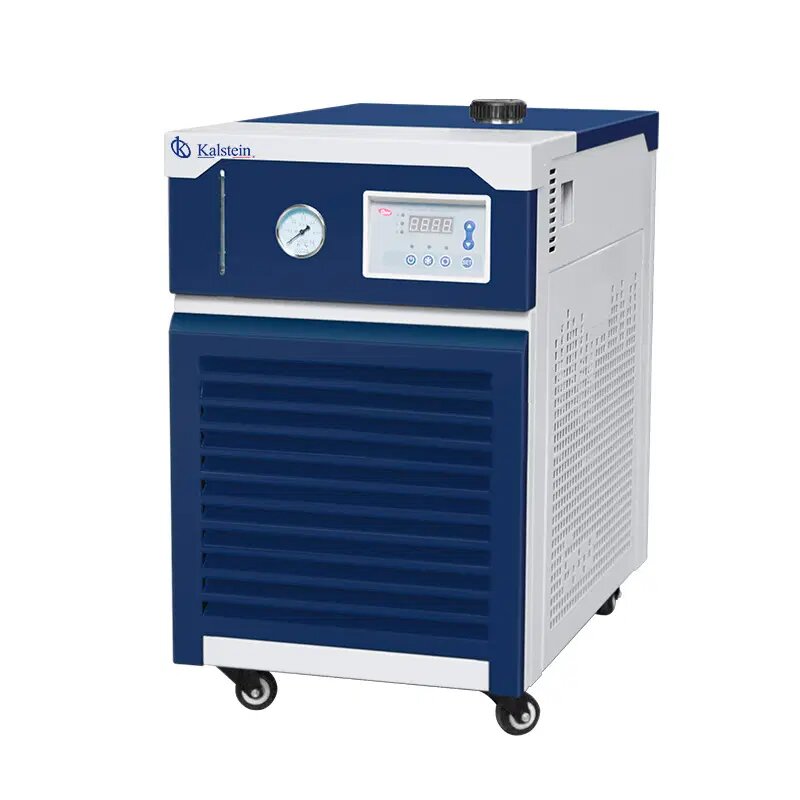In the world of scientific research and laboratories, having precise and reliable equipment is crucial for obtaining accurate and repeatable results. One of these essential pieces of equipment is the laboratory recirculating chiller. This device is vital for maintaining proper temperature conditions in various applications, from chemistry to molecular biology. Below, we present a detailed analysis of this equipment, its advantages, comparisons with competitors, and answers to frequently asked questions.
If you want to explore the high-end product catalog we have for you at KALSTEIN, visit us at https://kalstein.de/category-product/laboratory-line/recirculating-chiller/. We assure you that through our easy and feasible online PURCHASE channels, you will find the best prices on the MARKET. We remind you that we at KALSTEIN MANUFACTURE high-level Laboratory Equipment for SALE. https://kalstein.de/
What is a Laboratory Recirculating Chiller?
A laboratory recirculating chiller is a device designed to provide precise temperature control by recirculating a refrigerant fluid. This equipment is essential in processes where maintaining a constant temperature is required, such as in the operation of chemical reactors, analytical systems, mass spectrometry, and other heat-sensitive equipment.
These chillers operate using a refrigeration cycle that includes a compressor, a condenser, an evaporator, and a recirculating pump. The refrigerant fluid continuously circulates, absorbing heat from the connected equipment and dissipating it outside the system, thus ensuring a stable temperature.
Advantages of Using a Recirculating Chiller
The primary advantage of using a laboratory recirculating chiller is the ability to maintain a constant and precise temperature, which is crucial for the reproducibility of experiments. Additionally, these devices are highly efficient in terms of energy consumption, translating into significant long-term savings.
Another advantage is their versatility. They can be used in a wide range of applications, from cooling reactors and condensers to stabilizing biological samples. Moreover, many modern models are equipped with digital controls that allow for easy programming and temperature monitoring, thereby enhancing precision and user convenience.
Comparison of Recirculating Chillers: Kalstein, Wiener Lab, Labware, and Sartorius
To better understand the advantages of recirculating chillers, it is useful to compare them with similar products from other well-known brands in the market. Below is a comparative table of recirculating chillers from Kalstein, Wiener Lab, Labware, and Sartorius.
|
Feature |
Kalstein |
Wiener Lab |
Labware |
Sartorius |
|
Temperature Precision |
±0.1°C |
±0.2°C |
±0.1°C |
±0.05°C |
|
Temperature Range |
-20°C to 100°C |
-10°C to 80°C |
-20°C to 80°C |
-20°C to 100°C |
|
Cooling Capacity |
500W |
450W |
500W |
550W |
|
Energy Consumption |
600W |
650W |
620W |
580W |
|
Ease of Use |
Digital touch screen |
Analog controls |
LCD screen |
Digital touch screen |
Applications of the Recirculating Chiller
Laboratory recirculating chillers are used in various scientific fields. In chemistry, they are essential for maintaining the temperature of reactors and distillation systems, ensuring that reactions occur under controlled conditions. In biology, they are used to stabilize samples and reagents, which is fundamental for sensitive experiments like PCR and DNA sequencing.
In the field of physics, these chillers are used in high-precision experiments that require rigorous thermal control, such as in mass spectrometry and nuclear magnetic resonance (NMR), where temperature variations can affect measurement accuracy.
Innovations in Recirculating Chillers
Technological advancements have made modern recirculating chillers more efficient and easier to use than ever. Digital touch screens and programmable controls allow users to set and monitor temperature conditions with great precision. Moreover, many modern models include advanced safety features, such as overheating alarms and automatic shutdown systems in case of failures.
Another significant innovation is the incorporation of eco-friendly refrigeration systems that use less harmful refrigerants for the environment. This not only reduces environmental impact but also complies with the strictest international regulations.
Frequently Asked Questions about Recirculating Chillers
How long does a recirculating chiller last?
The lifespan of a recirculating chiller depends on usage and maintenance. With proper maintenance, these devices can last between 5 and 10 years.
What type of maintenance does a recirculating chiller require?
It is important to perform regular maintenance, such as cleaning the filters, checking the connections, and ensuring the refrigeration system is working correctly. It is also recommended to periodically check refrigerant levels and make adjustments as necessary.
Conclusion: The Importance of the Recirculating Chiller in the Modern Laboratory
In conclusion, the laboratory recirculating chiller is an indispensable tool for any laboratory that requires precise temperature control. Its ability to maintain stable conditions and its energy efficiency make it an ideal choice for a wide range of scientific applications.
Choosing the right chiller can make a significant difference in the quality of your experimental results. By comparing available options, such as those from Kalstein, Wiener Lab, Labware, and Sartorius, you can find the equipment that best suits your specific needs. With the information provided, we hope you can make an informed decision and fully leverage the advantages of these innovative devices.

